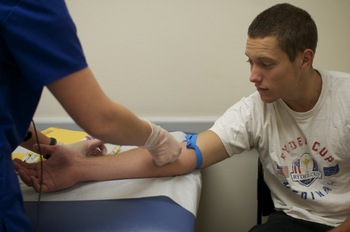Junior Cal Melberg becomes ‘the match’
After attending a Be the Match bone marrow donor registration event on campus last May, UW–Madison junior Cal Melberg of Chippewa Falls knew his chances of ever being matched were slim. Then, in September, he got the call.
“I had just gotten to my research lab where I work, when my phone went off,” recalls Melberg. “I was so astounded that this incredibly random responsibility was given to me. My general thought was that if this event can make me this excited, maybe it can inspire others to want this feeling.”

Cal Melberg being prepped for a blood test before his bone marrow donation, which he expects to happen in March.
Photo: caldonatesmarrow.blog.com
According to the Be the Match organization, “Thousands of people with blood cancers like leukemia, lymphoma, sickle cell anemia and other life-threatening diseases depend on a bone marrow or cord blood transplant to save their life.”
To share his story, Melberg began a blog, Cal and the Big Needle, in the hope that it will eliminate some of the misconceptions about bone marrow donation and encourage more people to register.
“I want people to know what it’s like to be the match, to feel that certain responsibility to save a random person’s life,” says Melberg. “I hope that someone who gets matched can reference my blog and see what it’s like and what to expect.”
Melberg came up with the name for the blog before finding out that his procedure would in fact involve a surprisingly small needle. Depending on donation center requests, donors can either go through the traditional donation procedure or donate stem cells through their peripheral blood.
Christian M. Capitini, a UW Health specialist in pediatric hematology and oncology, explains that donors often prefer the latter because it is a much less invasive procedure.
“I want people to know what it’s like to be the match, to feel that certain responsibility to save a random person’s life.”
Cal Melberg
“You don’t have to get any sedation or anesthesia,” says Capitini. “They put two IV lines into your arms and they hook you up to a machine that will collect the stem cell product out of the blood. … The machine will collect those stem cells and return whatever it doesn’t need, like platelets and red blood cells.”
Even though it is less invasive, the peripheral blood method is not without its side effects. Five days before the procedure, Melberg will begin receiving injections of filgastrim, a drug that moves peripheral blood stem cells from the marrow into the bloodstream. Donors often experience bone or muscle aches after the injections, but Melberg says he is simply excited about the actual donation.
“Although it’ll consist of six hours in a hospital bed with blood being ejected and re-injected continuously, I’ll be able to relax, watch movies, chat with my girlfriend, just kind of lay back and take it easy for once,” he says.
Melberg admits that his journey hasn’t been easy, but says he never thought twice about going through with the donation process.
“This obviously isn’t the normal burden for a full-time student. But any student could do what I’ve done, and I’m sure most would take the same jump.”
Cal Melberg
“Just the other day I had to drive up to Duluth for a three-hour physical and vein assessment,” he says. “I missed a full day of class, and had the exhaustion of the trip set in afterward. This obviously isn’t the normal burden for a full-time student. But any student could do what I’ve done, and I’m sure most would take the same jump.”
After this and other blood tests, the final date for donation was set for Nov. 26. However, it had to be pushed back a few months to give the bone marrow recipient more time to prepare for the procedure.
Melberg says that if everything goes well, he expects to donate in March. Until then, he plans to keep his blog updated.
He hopes others see donating as a life-changing event — not just for the recipient, but for themselves as well.
“This is an event that I’ll never forget and be able to proudly recount in the future,” say Melberg. “I would love to see everyone who is willing to be in my position get their chance; it’s an amazing journey.”
Tags: cancer, health care, students, UW Health




